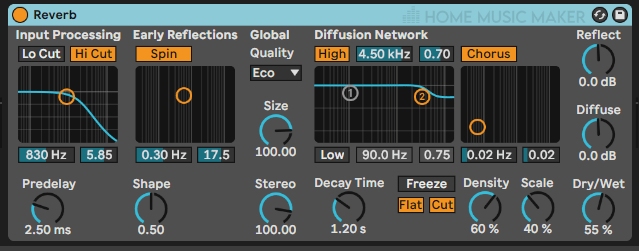Table of Contents
Welcome to the world of sonic enhancement with Hoopr! Today, we are talking about Reverbs! Reverbs take your videos to the next level with its excellent sonic properties that can give your visual content an extra dimension. You can master the soundscapes of reverb to make your videos sparkle and add a creative twist to your work.

Whether you’re a novice or a seasoned pro, Hoopr can help unlock your videos’ potential and take you to the next level of production.
Have you ever heard a song on the radio and felt like the sound was bouncing off the walls? Or, have you ever heard your own voice in a room, and it seemed to echo back to you? That’s what we call reverb.
Reverb is a type of sound effect you create when a sound bounces off a surface. For example, when you clap your hands in a room, the sound travels and hits the walls, ceiling, and floors. The sound then bounces off of these surfaces, creating a reverberated sound.
Reverb can add depth and texture to a song, making it sound bigger and fuller. It’s also used in movies to create the feeling of being in a certain space, like a cave or a church.
Thus, reverb makes music sound better. Musicians use reverb to add atmosphere to their songs. Reverb can make a small room sound larger and a large room sound even bigger. It can also make a song sound closer or further away from you.
In movies or video games, you can hear the sound of the walls and other surfaces in the room, and it helps to give the scene more atmosphere and realism.
Are you an audio engineer, music producer, or sound designer? If so, you know that reverb is essential to any sound mix. Reverb is an essential tool to create depth and texture in a mix. You can also use it to make a track sound bigger and wider.
But there are a few different types of reverb you should know about. In this section, we’ll take a closer look at the different reverb types and how you can use them in your mixes.
Each type of reverb has its unique sound and can be used differently to create different sounds in your mix. It’s essential to experiment with different types of reverb to find the right sound for your mix.
Using reverb in video editing can be a potent tool in creating a unique and dynamic look and feel to your video productions. Reverb is an effect that creates a sense of space and depth by adding reverberation to the original audio. It can create an immersive environment that envelops the viewer in the scene.
Reverbs can also create an emotional atmosphere that can evoke certain feelings in the viewer. When used correctly, reverb can significantly enhance the overall sound quality of a video. It can also add depth and texture to a scene and make it more realistic.
Reverbs can also add a sense of motion to a scene and make it feel as if the viewer is actually in the environment. However, it is important to understand the effects of reverb before using it in your video projects.
Reverbs can build on a lot of noise to the overall audio, making it difficult to hear the original audio clearly. It can also muffle the sound of certain instruments or sounds, making them difficult to distinguish in the mix. It is important to take the time to experiment with reverb settings and find the settings that work best for your video production.
Different reverb settings can have different effects on the sound of your video. For example, a higher reverb setting may create a more ethereal sound, while a lower setting may be more subtle and focused. When using reverb, it is important to keep in mind the overall atmosphere of the scene. Reverb can easily overpower certain elements in the scene if used too heavily.
Additionally, it can create an artificial feeling if used too much, which can take away from the realism of the scene. In general, reverb is an incredibly powerful tool that you can use to add depth, texture, and motion to a video.
However, it is essential to experiment with different settings and find the best work for your project. With a little bit of practice, you can create a unique and dynamic look and feel for your videos.
You do not have to worry about anything if you know how to get high-quality, premium tracks for higher engagement minus the scary copyright claims and legal notices.
Whether you create content for Twitch, YouTube, Twitter, or Instagram, you need to be well-versed in the different copyright laws. And as you learn more about copyright in music, royalty-free music, and more, it gets easier for you to ensure fair use of others’ music as well.
And in case you are a YouTuber looking for copyright-safe music, Hoopr can help you learn about it, get royalty-free music, and skip the worry about legalities. Choose now to get going with your next video!